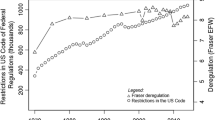Abstract
This paper analyzes the Baron and Myerson’s (B–M) (Econometrica 50: 911–930 [1982]) scheme of monopoly regulation, a standard representative of Bayesian mechanisms. As is well known, the hboxB–M mechanism (and other related mechanisms) have as an explicit starting point the assumption that the regulator has an unchallenged prior belief about the cost function of the regulated monopolist.We analyze here the consequences resulting from the possibility that this prior belief may be subject to influence or manipulable. As we show in detail, under the B–M scheme, consumers and the regulated monopoly are highly sensitive to the regulator’s prior belief about the (private) cost information of the monopolist. Therefore, if a regulator’s beliefs are unaccountable to and unverifiable by a higher ity, the regulator has both the incentive and the possibility to change and/or misrepresent his prior belief when facing pressure or payoffs from interest groups representing consumers or the regulated firm. The results here show that the outcomes under a B–M mechanism favoring one or another interest group can vary over a wide spectrum. The results are consistent with capture theory and rent-seeking explanations of monopoly regulation and suggest the need to exercise care in using the insights and results of Bayesian regulatory theory to inform practice.
Similar content being viewed by others
References
D Baron R.B Myerson (1982) ArticleTitle“Regulating a Monopolist with Unknown Costs” Econometrica 50 911–930
M.A Crew P.R Kleindorfer (1986) The Economics of Public Utility Regulation MIT Press Cambridge, MA
M.A Crew P.R Kleindorfer (2002) ArticleTitle“Regulatory Economics: Twenty Years of Progress?” Journal of Regulatory Economics 21 5–22 Occurrence Handle10.1023/A:1013661106129
J Finsinger I Vogelsang (1982) “Performance Indices for Public Enterprises” L.P Jones (Eds) Public Enterprise in Less Developed Countries. Cambridge University Press New York
A Gibbard (1973) ArticleTitle“Manipulation of Voting Schemes: A General Result” Econometrica 41 587–602
R Guesnerie J.J Laffont (1984) ArticleTitle“A Complete Solution to a Class of Principal-Agentbreak Problems with an Application to the Control of a Self-Managed Firm” Journal of Public Economics 25 329–369 Occurrence Handle10.1016/0047-2727(84)90060-4
J Hagerman (1990) ArticleTitle“Regulation by Price Adjustment” The RAND Journal of Economics 21 72–82
S Koray M.R Sertel (1990) ArticleTitle“Pretend-but-Perform Regulation and Limit Pricing” European Journal of Political Economy 6 451–472 Occurrence Handle10.1016/0176-2680(90)90001-Y
S Koray I Saglam (1999) “Bayesian Regulatory Mechanisms: Corruption and Learning” M Kaser M.R Sertel (Eds) In Contemporary Economic Issues. Volume 4: Economic Behavior and Design MacMillan Press London
Koray, S. and I. Saglam 2004. “Learning in Bayesian Regulatory Mechanisms.” Mimeo.
M Loeb W.A Magat (1979) ArticleTitle“A Decentralized Method for Utility Regulation” Journal of Law and Economics 22 399–404
T.P Lyon (1996) ArticleTitle“Evaluating the Performance of Non-Bayesian Regulatory Mechanisms” Journal of Regulatory Economics 9 41–60 Occurrence Handle10.1007/BF00134818
E Maskin J Riley (1984) ArticleTitle“Monopoly With Incomplete Information” The Rand Journal of Economics 15 171–196
J Mirrlees (1971) ArticleTitle“An Exploration in the Theory of Optimum Income Taxation” Review of Economic Studies 38 175–208
M Mussa S Rosen (1978) ArticleTitle“Monopoly and Product Quality” Journal of Economic Theory 18 301–317 Occurrence Handle10.1016/0022-0531(78)90085-6
R.B Myerson (1979) ArticleTitle“Incentive Compatibility and the Bargaining Problem” Econometrica 47 61–74
R.A Posner (1974) ArticleTitle“Theories of Economic Regulation” Bell Journal of Economics 5 335–358
D Sappington D Sibley (1988) ArticleTitle“Regulating Without Cost Information: The Incremental Surplus Subsidy Scheme” International Economic Review 29 297–306
G Tullock (1967) ArticleTitle“The Welfare Costs of Tariffs, Monopolies, and Theft” Western Economic Journal 5 224–232
I Vogelsang (1988) ArticleTitle“A Little Paradox in the Design of Regulatory Mechanisms” International Economic Review 29 467–476 Occurrence HandleMR973058
I Vogelsang (2002) ArticleTitle“Incentive Regulation and Competition in Public Utility Markets: A 20-Year Perspective” Journal of Regulatory Economics 22 5–27 Occurrence Handle10.1023/A:1019992018453
I. Vogelsang (2004) “Transmission Pricing and Performance-Based Regulation” presented at Carnegie-Mellon Conference on Electricity Transmission in Deregulated Markets: Challenges, Opportunities, and Necessary R&D Agenda Pittsburgh
Author information
Authors and Affiliations
Corresponding author
Rights and permissions
About this article
Cite this article
Koray, S., Saglam, I. The Need for Regulating a Bayesian Regulator. J Regul Econ 28, 5–21 (2005). https://doi.org/10.1007/s11149-005-2353-z
Issue Date:
DOI: https://doi.org/10.1007/s11149-005-2353-z




